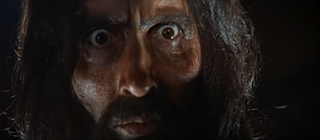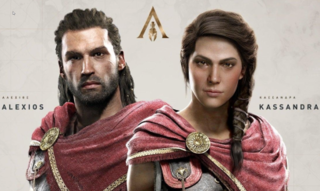
Usagi Tsukino, better known as Sailor Moon, is a Japanese superheroine and the protagonist of the Sailor Moon franchise created by Naoko Takeuchi. She is introduced in chapter No. 1 of the manga, "Usagi – Sailor Moon", as a carefree Japanese schoolgirl who can transform into the magical "Guardian of Love and Justice", Sailor Moon.
Veritas: The Quest is a television program that aired in 2003, following a rebellious but intelligent teenager, Nikko Zond, as he discovers that his father Solomon's profession is much more mystical and adventurous than he previously thought. Solomon and his team search for the answers to some of the world's mysteries, a quest began because of the mysterious disappearance of Nikko's mother during an archaeological dig. Thus begins Nikko's fantastical journey into an Indiana Jones-style adventure with his father and his colleagues in trying to follow in his mother's footsteps to discover what strange secrets she was uncovering. The series was cancelled in the United States by ABC with only four episodes being aired. All thirteen produced episodes aired on Sci Fi Channel in the United Kingdom, on Rai 2 and Rai 4 in Italy, and Canal Sony.

Crystal skulls are human skull hardstone carvings made of clear or milky white quartz, claimed to be pre-Columbian Mesoamerican artifacts by their alleged finders; however, these claims have been refuted for all of the specimens made available for scientific studies. The results of these studies demonstrated that those examined were manufactured in the mid-19th century or later, almost certainly in Europe, during a time when interest in ancient culture abounded. The skulls appear to have been crafted in Germany, quite likely at workshops in the town of Idar-Oberstein, which was renowned for crafting objects made from imported Brazilian quartz in the late 19th century.

Yugi Mutou is a fictional character and the main protagonist of the Yu-Gi-Oh! manga series created by Kazuki Takahashi. Yugi is introduced as a teenager who is solving an ancient Egyptian puzzle known as the Millennium Puzzle, hoping it will grant him his wish of forming bonds. After solving the Puzzle, Yugi revives an ancient spirit initially known as Dark Yugi; his true identity is later revealed to be a pharaoh of Ancient Egypt named Atem. Over the course of the series, Yugi forms friendships with the supporting cast, interacts with Atem, and learns about his past. Besides the original manga, Yugi has also appeared in anime adaptations, films and video games based on the franchise. His ace duel monster card is the "Dark Magician".

Leonardo da Vinci was an Italian Renaissance painter and polymath who achieved legendary fame and iconic status within his own lifetime. His renown primarily rests upon his brilliant achievements as a painter, the Mona Lisa and The Last Supper, being two of the most famous artworks ever created, but also upon his diverse skills as a scientist and inventor. He became so highly valued during his lifetime that the King of France bore him home like a trophy of war, supported him in his old age and, according to legend, cradled his head as he died.
The use of nanotechnology in fiction has attracted scholarly attention. The first use of the distinguishing concepts of nanotechnology was "There's Plenty of Room at the Bottom", a talk given by physicist Richard Feynman in 1959. K. Eric Drexler's 1986 book Engines of Creation introduced the general public to the concept of nanotechnology. Since then, nanotechnology has been used frequently in a diverse range of fiction, often as a justification for unusual or far-fetched occurrences featured in speculative fiction.
The Norse mythology, preserved ancient Icelandic texts such as the Poetic Edda, the Prose Edda, and other lays and sagas, was little known outside Scandinavia until the 19th century. With the widespread publication of Norse myths and legends at this time, references to the Norse gods and heroes spread into European literary culture, especially in Scandinavia, Germany, and Britain. In the later 20th century, references to Norse mythology became common in science fiction and fantasy literature, role-playing games, and eventually other cultural products such as Japanese animation. Storytelling was an important aspect of Norse mythology and centuries later, with the rediscovery of the myth, Norse mythology once again relies on the impacts of storytelling to spread its agenda.

The life of the notorious Russian mystic Grigori Rasputin has been the subject of a variety of media since his death in 1916.

The Epic of Gilgamesh has directly inspired many manifestations of literature, art, music, and popular culture throughout history. It was extremely influential during the Bronze Age and Iron Age in the Middle East, but gradually fell into obscurity during classical antiquity. The story was rediscovered in the 19th century, and began to regain popular recognition and influence in the 20th century.

Nancy Drew: Legend of the Crystal Skull is the 17th installment in the Nancy Drew point-and-click adventure game series by Her Interactive. It is available for play on Microsoft Windows platforms. It has an ESRB rating of E for moments of mild violence and peril. Players take on the first-person view of fictional amateur sleuth Nancy Drew and must solve the mystery through interrogation of suspects, solving puzzles, and discovering clues. There are two levels of gameplay, Junior and Senior detective modes, each offering a different difficulty level of puzzles and hints, however neither of these changes affect the plot of the game. The game is loosely based on the book The Mardi Gras Mystery (1988).
Mind control has proven a popular subject in fiction, featuring in books and films such as The Manchurian Candidate and The IPCRESS File, both stories advancing the premise that controllers could hypnotize a person into murdering on command while retaining no memory of the killing. As a narrative device, mind control serves as a convenient means of introducing changes in the behavior of characters, and is used as a device for raising tension and audience uncertainty in the contexts of the Cold War and terrorism. Mind control has often been an important theme in science fiction and fantasy stories. Terry O'Brien comments: "Mind control is such a powerful image that if hypnotism did not exist, then something similar would have to have been invented: the plot device is too useful for any writer to ignore. The fear of mind control is equally as powerful an image."

Ancient Mesoamericans were the first people to invent rubber balls, sometime before 1600 BCE, and used them in a variety of roles. The Mesoamerican ballgame, for example, employed various sizes of solid rubber balls and balls were burned as offerings in temples, buried in votive deposits, and laid in sacred bogs and cenotes.

Yu-Gi-Oh! 5D's is the second main spin-off of the Yu-Gi-Oh! franchise, succeeding Yu-Gi-Oh! GX, in celebration of the 40th anniversary of Weekly Shōnen Jump and the 15th anniversary of V Jump. The series aired from April 2008 to March 2011.

Ancient astronauts have been addressed frequently in science fiction and horror fiction. Occurrences in the genres include:

Assassin's Creed II is a 2009 action-adventure video game developed by Ubisoft Montréal and published by Ubisoft. It is the second major installment in the Assassin's Creed series, and the sequel to 2007's Assassin's Creed. The game was first released on the PlayStation 3 and Xbox 360 in November 2009, and was later made available on Microsoft Windows in March 2010 and OS X in October 2010. Remastered versions of the game and its two sequels, Assassin's Creed: Brotherhood and Assassin's Creed: Revelations, were released as part of The Ezio Collection compilation for the PlayStation 4 and Xbox One on November 15, 2016, and for the Nintendo Switch on February 17, 2022.

Assassin's Creed is a historical action-adventure video game series and media franchise published by Ubisoft and developed mainly by its studio Ubisoft Montreal using the game engine Anvil and its more advanced derivatives. Created by Patrice Désilets, Jade Raymond, and Corey May, the Assassin's Creed video game series depicts a fictional millennia-old struggle between the Order of Assassins, who fight for peace and free will, and the Knights Templar, who desire peace through order and control. The series features historical fiction, science fiction, and fictional characters intertwined with real-world historical events and historical figures. In most games, players control a historical Assassin while also playing as an Assassin Initiate or someone caught in the Assassin–Templar conflict in the present-day framing story. Considered a spiritual successor to the Prince of Persia series, Assassin's Creed took inspiration from the novel Alamut by the Slovenian writer Vladimir Bartol, based on the historical Hashashin sect of the medieval Middle East.
Jane MacLaren Walsh is an anthropologist and researcher at the Smithsonian's National Museum of Natural History in Washington, D.C. She is known for her role in exposing faked pre-Columbian artifacts.

Yu-Gi-Oh!, known in Japan as Yu-Gi-Oh! Duel Monsters and alternatively subtitled Rulers of the Duel in the United States and Canada, is a Japanese anime series animated by Studio Gallop based on the Yu-Gi-Oh! manga series written by Kazuki Takahashi. It is the second anime adaptation of the manga following the 1998 anime television series produced by Toei Animation. The series revolves around a young high school boy named Yugi Muto who battles opponents in the Duel Monsters card game. The series begins from chapter 60 in volume 7 before loosely adapting the remaining chapters of the original manga by making story changes that conflict with the events of the manga canon.

Assassin's Creed Odyssey is a 2018 action role-playing video game developed by Ubisoft Quebec and published by Ubisoft. It is the eleventh major installment in the Assassin's Creed series and the successor to 2017's Assassin's Creed Origins. Like its predecessor, the game features a large open world and adopts many elements from the role-playing genre, putting more emphasis on combat and exploration than stealth. Naval combat from previous titles in the series also plays a prominent role in Odyssey. The game's plot tells a mythological history of the Peloponnesian War between Athens and Sparta from 431 to 422 BC. Players control a Spartan mercenary, who fights on both sides of the conflict as they attempt to find their family and eliminate the mysterious Cult of Kosmos. Odyssey also continues the story arc of Layla Hassan, a major character introduced in Origins, who relives the mercenary's memories through the Animus device to find a powerful artifact.

Alexios and Kassandra are two interconnected fictional characters in Ubisoft's Assassin's Creed video game franchise, first appearing as the player characters of the 2018 video game Assassin's Creed Odyssey. Alexios and Kassandra are portrayed through performance capture by Michael Antonakos and Melissanthi Mahut respectively. Leonidas Castrounis and Maria Syrgiannis respectively voice the two characters as children in flashbacks.













